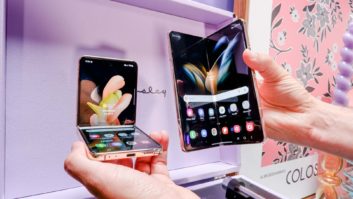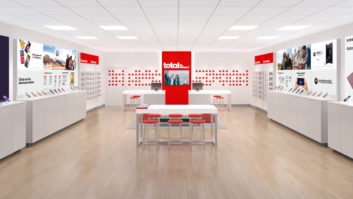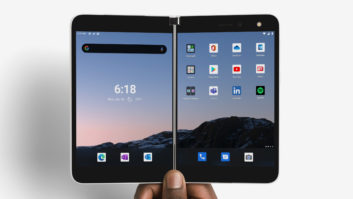NEW YORK – Wireless carriers are changing rate plans, launching aggressive promotions, adding new services, and upgrading their networks to woo consumers in a mature market in which comScore estimates 248.2 million people ages 13 and up, out of a total U.S. population of 321.5 million, already use cellphones.
Carriers are fighting hard to generate new revenue streams by promoting cellular-equipped tablets, connecting cars and other M2M devices to the Internet, and stepping consumers up to smartphones, although smartphone users already account for 76.7 percent of all U.S. cellphone users ages 13 and up, com- Score statistics show.
Carriers, however, get most of their revenues from cellphone users, and they’ve focused intensely on growing their cellphone subscriber bases and fighting off competitors’ aggressive efforts to poach their subscribers. In recent weeks, for example, AT&T became the first U.S. carrier to offer a nationwide bundle of TV and cellphone service following its acquisition of satellite-TV provider DirecTV. The carrier also launched a limited-time promo offering a bounty of up to $500 to DirecTV and U-verse TV customers who switch to AT&T cell service.
For its part, Sprint, whose subscriber base slipped into fourth place behind a resurgent TMobile, countering T-Mobile’s cross-border calling initiatives with its own Open World initiative. The carrier also continues to upgrade its network to improve data-speed performance. And Verizon Wireless unveiled a simpler rate-plan structure that cuts the price of some access-line charges and some shared-data plans while eliminating other data tiers to simplify choices.
“The U.S. mobile market is dynamic, with 2015 seeing a continued fight for network superiority joined with increased emphasis on customer experience and competitive plans for both high and low ends of the market as well as attempts to retain and shift the core subscriber base at each of the top four carriers,” said Strategy Analytics.
The company forecasts a small 4 percent compound annual growth in retail subscriptions (excluding CE devices) from 2015-2020, with service revenues growing at a CAGR of only 0.2 percent.
Here’s what the carriers announced to get their share of that 4 percent growth:
AT&T: The company became the first U.S. carrier to offer a nationwide bundle of discounted TV and cellphone service following its July 24 acquisition of satellite-TV provider DirecTV. The new All In One service plans are available to people who sign up for DirecTV or U-verse service for the first time.
As part of the launch, AT&T is delivering DirecTV content to a DirecTV subscriber’s phone through a DirecTV app.
The company also launched a limited-time promo that offers up to $500 to DirecTV and U-verse TV customers who switch to AT&T cell service. The offer is available in both AT&T-branded stores and indirect retailers.
For each cellular line that they port in when buying a postpaid smartphone on an installment-purchase plan, DirectTV and U-Verse subscribers get a $300 bill credit plus another $200 for trading in an eligible smartphone. A family of four could get a total of $2,000 in credits.
Sprint: The carrier countered T-Mobile’s crossborder calling initiative with its own Open World initiative.
Open World offers free unlimited calls and texts to Mexico and Canada from the U.S., calls starting at 5 cents/minute from the U.S. to Latin America and to more than 180 other countries, and free unlimited calling for subscribers traveling within Canada, Mexico, and most Latin American countries to any location within those areas. The free calls don’t count against the subscriber’s domestic bucket of voice minutes and text, a spokesperson said.
On top of that, Open World offers 1GB of free 3G data when customers travel in Open World countries, and the data usage doesn’t count against a user’s data bucket.
The Open World countries where U.S. travelers get free unlimited calls and free 1GB of data are Mexico, Canada, Dominican Republic, Argentina, Brazil, Chile, Colombia, Costa Rica, El Salvador, Guatemala, Honduras, Nicaragua, Panama and Paraguay. More counties in South America are coming.
Separately, the carrier continued to upgrade its network. Sprint president/CEO Marcelo Claure said the company is “positioned for network parity or superiority over the next two years,” thanks to multiple initiatives that include upgrading almost all cell sites to tri-band (800MHz, 1.8GHz and 2.5GHz) operation.
Verizon: The company has long contended it wouldn’t be dragged into the price-war mud, but it has stepped cautiously into the puddle up to its ankles.
In August, the carrier unveiled a simpler rate-plan structure that cuts the price of some access-line charges and some shared-data plans while eliminating other data tiers to simplify choices.
The small, medium, large and extra-large plans all come with unlimited talk and text and data sharing for up to 10 devices. The company also eliminated the option of getting a two-year contract with subsidized-phone prices.
Monthly access charges per phone go to $20/month from $40 for customers who have a contract and from $15 or $25 for phones previously bought on an equipment installment plan.
The new shared-data plans include the small plan, which charges $30/month for 1GB of shared data, unchanged from before. The medium plan at $45/month offers 3GB compared to a previous $50 for 3 GB, and the large plan at $60/month provides 6GB compared to a previous $70 for 6GB.
The extra-large plan costs $80/month for 12GB of data compared to a current promotional price of $80 for 10GB.
The carrier dropped shared-data plans of 2GB at $40 and 4GB at $60, though consumers can add an extra 1GB to their plans at an additional $15/month.
KPhone Enters U.S. Market
RANCHO CUCAMONGA, CALIF. – Another maker of unlocked smartphones is entering the U.S. market and targeting retail channels, but unlike some competitors, this one has the backing of a parent company that is the third largest cellphone supplier in China.
Beijing-based K-Touch is the parent, and its U.S. company is KPhone USA, which plans October U.S. availability of the LTE-equipped K5 Android smartphone at a suggested retail price of $349. The K5 features Android 5.0, 5-inch 1080 by 720 IPS display, Qualcomm quad-core Snapdragon 410 processor, and 2GB RAM.
TextNow Hits Stores
WATERLOO, ONTARIO — TextNow Wireless, an MVNO that offers low-cost hybrid Wi-Fi/cell service, has begun rolling out phones to brick-and-mortar dealers for the first time, starting with Fry’s Electronics.
TextNow service had been available only through the company’s web store.
TextNow phones send calls and texts via VoIP through a Wi-Fi network when the Wi-Fi connection is strong enough, then hands off the call to Sprint’s 3G/4G network when the Wi-Fi connection is lost.













